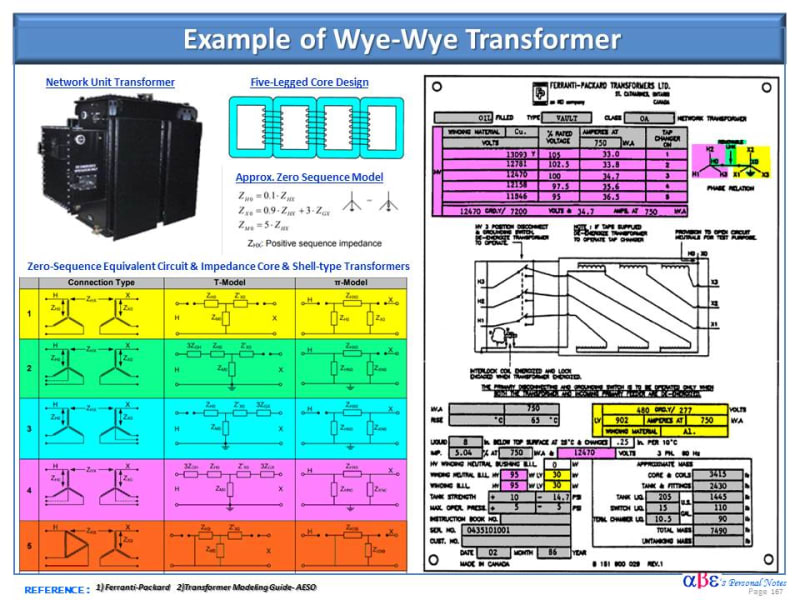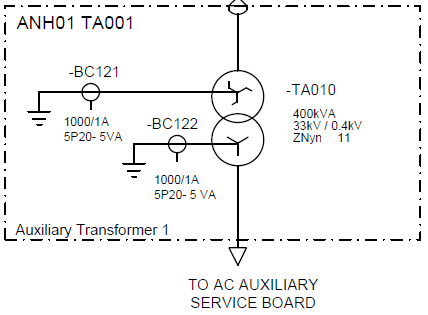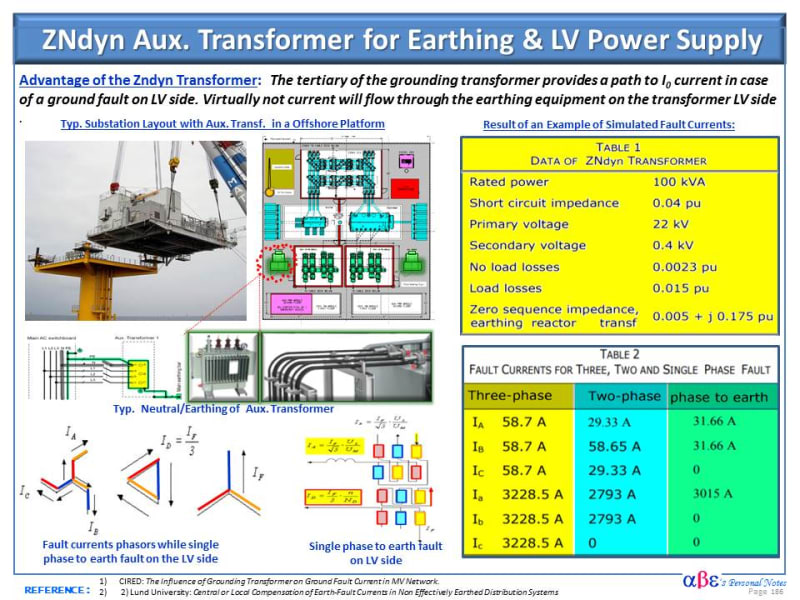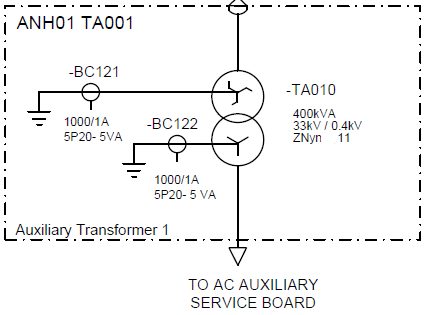Navigation
Install the app
How to install the app on iOS
Follow along with the video below to see how to install our site as a web app on your home screen.
Note: This feature may not be available in some browsers.
More options
Style variation
-
Congratulations TugboatEng on being selected by the Eng-Tips community for having the most helpful posts in the forums last week. Way to Go!
You are using an out of date browser. It may not display this or other websites correctly.
You should upgrade or use an alternative browser.
You should upgrade or use an alternative browser.
wye - wye transformer 2
- Thread starter matieij
- Start date
- Status
- Not open for further replies.
RRaghunath
Electrical
ZNyn transformer is is not YNyn transformer.
Tertiary winding is not relevant.
In large YNyn transformers (typically 100MVA and above), it is a practice to provide tertiary delta winding to allow circulation of third harmonic currents (required for magnetisation of transformer core).
Tertiary winding is not relevant.
In large YNyn transformers (typically 100MVA and above), it is a practice to provide tertiary delta winding to allow circulation of third harmonic currents (required for magnetisation of transformer core).
- Thread starter
- #3
The purpose of Z connection is to serve part of the function of stabilizing tertiary-ie reduced zero sequence impedance for LG faults so as to detect ground fault. Some utilities used to have YNzn instead of YNynd11 to avoid the cost of extra stabilizing winding. Today the understanding and practice(at least in India) is to avoid stabilizing tertiary in all Ynyn connected three phase transformers with three limbed core construction, when both sides are with solidly grounded systems.
- Moderator
- #5
A floating neutral on a wye transformer primary is not a good idea.
A neutral/ground reference may be created with a zi-zag transformer, or a wye:delta transformer.
The wye delta may be a separate wye:delta grounding transformer, a tertiary winding or the phantom delta formed by a three legged core.
If a zig-zag grounding transformer is used then there is no need for a delta.
If a wye:delta transformer, a delta tertiary winding, or a phantom delta is in place there is no need of a zig-zag transformer.
I have not seen a phantom delta relied upon to provide stability, but it is well to be aware of the possible unintended consequences of a wye:delta, real or phantom.
One issue is that de-energizing one primary phase may not de-energize the corresponding secondary phase.
A related issue is that de-energizing two primary phases may result in approximately 50% voltage to be present on the corresponding secondary phases.
Another wye:delta issue is that a wye:delta bank will transfer energy from the healthy phases to a faulted phase and increase the fault current of a single line to ground fault above the value calculated from the supply impedance.
This may result in an upstream phase to ground fault blowing a downstream fuse on a wye:delta transformer bank.
Bill
--------------------
"Why not the best?"
Jimmy Carter
A neutral/ground reference may be created with a zi-zag transformer, or a wye:delta transformer.
The wye delta may be a separate wye:delta grounding transformer, a tertiary winding or the phantom delta formed by a three legged core.
If a zig-zag grounding transformer is used then there is no need for a delta.
If a wye:delta transformer, a delta tertiary winding, or a phantom delta is in place there is no need of a zig-zag transformer.
I have not seen a phantom delta relied upon to provide stability, but it is well to be aware of the possible unintended consequences of a wye:delta, real or phantom.
One issue is that de-energizing one primary phase may not de-energize the corresponding secondary phase.
A related issue is that de-energizing two primary phases may result in approximately 50% voltage to be present on the corresponding secondary phases.
Another wye:delta issue is that a wye:delta bank will transfer energy from the healthy phases to a faulted phase and increase the fault current of a single line to ground fault above the value calculated from the supply impedance.
This may result in an upstream phase to ground fault blowing a downstream fuse on a wye:delta transformer bank.
Bill
--------------------
"Why not the best?"
Jimmy Carter
-
1
- #6
Enclosed is a recommended good old publication regarding "THE WHYS OF THE WYES -The behavior of Transformer Y Connections".
Below is a sample of a five-legged Core Design used in one of the Utilities that I worked and typical zero-sequence modeling data for two winding wye-wye transformers.

Below is a sample of a five-legged Core Design used in one of the Utilities that I worked and typical zero-sequence modeling data for two winding wye-wye transformers.

- Thread starter
- #7
Thanks for your reply.
I think I am starting to better understand the behaviour of the Y-Y transformers. Let's see if I am able to elaborate a good technical justification to convince the client that a ZNyn11 transformer is the best choice for our application and not ZNyn(d)11.
I think I am starting to better understand the behaviour of the Y-Y transformers. Let's see if I am able to elaborate a good technical justification to convince the client that a ZNyn11 transformer is the best choice for our application and not ZNyn(d)11.
- Thread starter
- #8
Hi all,
To sum up what I have understood:
- As in my case we have a ZNyn transformer -> no need of stabilization delta.
- Zero sequence currents will appear when having unbalance load or in case of earth fault and will circulate through both neutral points and the ground.
Then 2 questions come to my mind,
-> How having a zig-zag can avoid the stabilization delta?
-> How should the transformer neutral size be specified? Any special consideration? should it be specified for continuous current circulation?
To sum up what I have understood:
- As in my case we have a ZNyn transformer -> no need of stabilization delta.
- Zero sequence currents will appear when having unbalance load or in case of earth fault and will circulate through both neutral points and the ground.
Then 2 questions come to my mind,
-> How having a zig-zag can avoid the stabilization delta?
-> How should the transformer neutral size be specified? Any special consideration? should it be specified for continuous current circulation?
- Moderator
- #9
What size of transformer?
Transmission or distribution?
Will the supply source be three wire or four wire?
For a large transmission transformer with a three wire supply, you probably should have a tertiary winding.
For a small or moderate sized distribution transformer with a neutral conductor carried with the phase conductors and connected to the transformer star point, you may not need a tertiary winding.
Bill
--------------------
"Why not the best?"
Jimmy Carter
Transmission or distribution?
Will the supply source be three wire or four wire?
For a large transmission transformer with a three wire supply, you probably should have a tertiary winding.
For a small or moderate sized distribution transformer with a neutral conductor carried with the phase conductors and connected to the transformer star point, you may not need a tertiary winding.
Bill
--------------------
"Why not the best?"
Jimmy Carter
- Thread starter
- #10
Replying to Bill's questions:
It is a 400 kVA 33/0.4 kV ZNyn11 distribution transformer to supply the auxiliaries of an offshore substation (various UPS rectifiers are part of the substation auxiliaries). See below:

On the primary side we have 3 cables from the 33 kV bus and on the secondary side we distribute the neutral (3ph + N).
Still facing some difficulties to answer below questions:
-> How having a zig-zag can avoid the stabilization delta?
-> How should the transformer neutral size be specified? Any special consideration? should it be specified for continuous current circulation?
It is a 400 kVA 33/0.4 kV ZNyn11 distribution transformer to supply the auxiliaries of an offshore substation (various UPS rectifiers are part of the substation auxiliaries). See below:

On the primary side we have 3 cables from the 33 kV bus and on the secondary side we distribute the neutral (3ph + N).
Still facing some difficulties to answer below questions:
-> How having a zig-zag can avoid the stabilization delta?
-> How should the transformer neutral size be specified? Any special consideration? should it be specified for continuous current circulation?
- Moderator
- #11
Some confusion;
A Zig-zag transformer is not a tertiary winding.
Zig-zag transformers were historically used to provide a neutral and a ground reference to a delta secondary.
A delta secondary or tertiary winding abhors an unbalance is used to provide both stabilization and a path for magnetizing currents when a three wire circuit feeds a wye primary.
with a submarine supply with three cables you may expect unbalances due to unequal cable reactances.
I have had serious problems with about 300 meters of submarine cable.
You may expect heavy circulating currents in the delta.
I suggest considering a delta/wye transformer.
Others with more offshore experience may have better suggestions.
Bill
--------------------
"Why not the best?"
Jimmy Carter
A Zig-zag transformer is not a tertiary winding.
Zig-zag transformers were historically used to provide a neutral and a ground reference to a delta secondary.
A delta secondary or tertiary winding abhors an unbalance is used to provide both stabilization and a path for magnetizing currents when a three wire circuit feeds a wye primary.
with a submarine supply with three cables you may expect unbalances due to unequal cable reactances.
I have had serious problems with about 300 meters of submarine cable.
You may expect heavy circulating currents in the delta.
I suggest considering a delta/wye transformer.
Others with more offshore experience may have better suggestions.
Bill
--------------------
"Why not the best?"
Jimmy Carter
-
1
- #12
Hi Waross,
I concur with you that there is some confusion regarding the application of this transformer.
The zigzag transformer, in this case, have dual application not only for neutral earthing (grounding) but also to supply the offshore substation auxiliary power.
Mathieij: Please help us to confirm the following:
1) The goal of this project is to connect from a 33kV delta system to a wye earthed (grounded) 400V auxiliary power.
2) The neutral/earthed transformer suggested by the client is a tertiary transformer with a buried delta winding. (Should the designation be ZNdyn11 instead ZNyn(d)11?
Assuming that the suggested transformer has a buried delta winding (ZNdyn11) this configuration has advantages over the ZNyn as indicated in the illustration below. The zigzag portion of the transformer help to reduce the harmonic content generated by the system.
Due to the expected high harmonic content because of the nonlinear load connected in the secondary (UPS for navigation light, computers, communication equipment, battery charger for DC power system, etc.), it is not unusual size the neutral feeder with the same size of the phase conductor. However, an engineering assessment or calculation it is suggested.
I hope this helps.

I concur with you that there is some confusion regarding the application of this transformer.
The zigzag transformer, in this case, have dual application not only for neutral earthing (grounding) but also to supply the offshore substation auxiliary power.
Mathieij: Please help us to confirm the following:
1) The goal of this project is to connect from a 33kV delta system to a wye earthed (grounded) 400V auxiliary power.
2) The neutral/earthed transformer suggested by the client is a tertiary transformer with a buried delta winding. (Should the designation be ZNdyn11 instead ZNyn(d)11?
Assuming that the suggested transformer has a buried delta winding (ZNdyn11) this configuration has advantages over the ZNyn as indicated in the illustration below. The zigzag portion of the transformer help to reduce the harmonic content generated by the system.
Due to the expected high harmonic content because of the nonlinear load connected in the secondary (UPS for navigation light, computers, communication equipment, battery charger for DC power system, etc.), it is not unusual size the neutral feeder with the same size of the phase conductor. However, an engineering assessment or calculation it is suggested.
I hope this helps.

What is the advantage of this over a Dyn connection? Is a ground source needed on the 33 kV side? Is the phase shift of a Dyn connection a problem? The Zndyn connection needs the delta tertiary to provide a ground source for the 0.4 kV system. Without the delta tertiary, a ground source is only provided on the zig-zag side.
GENERAL: wind power plants (WPP) are characterized by feeders with larger capacitance than conventional OH lines. The WPG also generates significant harmonic distortion and exposed to transient overvoltages, transformer saturation, power factor, reactive power, and voltage control issues.
The optimal design of the 33 kV and 0.4kV systems can be achieved with the proper selection of the neutral grounding/earthing auxiliary transformer. It is recognized that neutral grounding can be achieved in variates of connections such as YΔ, ZNyn, ZNdyn, ZNzn.
The best performance and cost for each application should be evaluated as well as the familiarity and experience for this application. In the USA, the most frequent application for a neutral/grounding transformer is Dyn and simple zig-zag unit. In Europe, the experience gained in several offshore projects favors the use of ZNdyn neutral grounding transformer for WPP.
Transformer Dyn is not a grounding transformer. Here are some potential issues:
1.1 During SLG fault, cause high phase-to-neutral voltages on the unfaulted phases.
1.2 Load unbalances can also cause neutral shifts and overvoltages.
1.3 The low zero sequence impedance of ZNyn & ZNdyn is an efficient way to mitigate the triplen harmonic (3rd, 9th, 15th...)
This might be a project requirement and a potential safety issue in a metallic platform for an offshore substation application. In general, the ground source facilitates the ground protective device coordination and monitoring of the system in the event of SLG fault.
The 30o phase shift of the Dyn by itself usually is not a problem. Special attention needs to be observed for connection to a standby generator to the LV bus for black-start, emergency or parallel mode.
I found the enclosed information very informative Link
The optimal design of the 33 kV and 0.4kV systems can be achieved with the proper selection of the neutral grounding/earthing auxiliary transformer. It is recognized that neutral grounding can be achieved in variates of connections such as YΔ, ZNyn, ZNdyn, ZNzn.
The best performance and cost for each application should be evaluated as well as the familiarity and experience for this application. In the USA, the most frequent application for a neutral/grounding transformer is Dyn and simple zig-zag unit. In Europe, the experience gained in several offshore projects favors the use of ZNdyn neutral grounding transformer for WPP.
Transformer Dyn is not a grounding transformer. Here are some potential issues:
1.1 During SLG fault, cause high phase-to-neutral voltages on the unfaulted phases.
1.2 Load unbalances can also cause neutral shifts and overvoltages.
1.3 The low zero sequence impedance of ZNyn & ZNdyn is an efficient way to mitigate the triplen harmonic (3rd, 9th, 15th...)
This might be a project requirement and a potential safety issue in a metallic platform for an offshore substation application. In general, the ground source facilitates the ground protective device coordination and monitoring of the system in the event of SLG fault.
The 30o phase shift of the Dyn by itself usually is not a problem. Special attention needs to be observed for connection to a standby generator to the LV bus for black-start, emergency or parallel mode.
I found the enclosed information very informative Link
RRaghunath
Electrical
Zero sequence impedance of ZNyn transformer for SLG faults on 400V side could be as high as 50% I read in a text book. Thus, the current will be as low as twice the rated current of 400V winding for SLG fault.
Adding a tertiary delta winding will help overcome this limitation. In case of systems with harmonics, it is important to size the tertiary delta winding generously to allow circulation (trapping) of the triplen harmonics in delta.
Adding a tertiary delta winding will help overcome this limitation. In case of systems with harmonics, it is important to size the tertiary delta winding generously to allow circulation (trapping) of the triplen harmonics in delta.
1) My earlier comment was for Power Transformers (220or132kV/33or11kV) where YNzn is adopted to save a stabilizing tertiary.(ie instead of YNdyn) or to get 30degree voltage shift.
2) The proposed application for wind farm - it can be YNd11yn or ZndY11. In case of ZNyn transformer, stabilizing tertiary (d) is required if the transformer has to meet unbalanced secondary loads or single phase loads.
3) Frankly I do not find any advantage for ZNd11yn over YNd11yn connection. The later will be cheaper solution. Here d requires 1/3 secondary line KVA rating
2) The proposed application for wind farm - it can be YNd11yn or ZndY11. In case of ZNyn transformer, stabilizing tertiary (d) is required if the transformer has to meet unbalanced secondary loads or single phase loads.
3) Frankly I do not find any advantage for ZNd11yn over YNd11yn connection. The later will be cheaper solution. Here d requires 1/3 secondary line KVA rating
- Thread starter
- #17
Hi all, thanks for your comments. I also think that there is some cofusion.
Having in mind that we are talking about a 3 leg distribution transformer 400 kVA 33/0.4 kV ZNyn11 to supply the auxiliaries of an offshore substation (various UPS rectifiers are part of the substation auxiliaries):

1.- I understand that having the neutral of the primary and secondary sides connected to the earth reduces the zero sequence impedance and creates a path for the zero sequence current mitigating the triplen harmonic effect. Is that rigth?
2.- How is the circulation of the zero sequence current?
3.- What is the difference between this transformer "configuration" and a transformer with an additional tertiary buried delta winding?
4.- Is there any special consideration when sizing the neutrals of the ZNyn11 transformer?
Having in mind that we are talking about a 3 leg distribution transformer 400 kVA 33/0.4 kV ZNyn11 to supply the auxiliaries of an offshore substation (various UPS rectifiers are part of the substation auxiliaries):

1.- I understand that having the neutral of the primary and secondary sides connected to the earth reduces the zero sequence impedance and creates a path for the zero sequence current mitigating the triplen harmonic effect. Is that rigth?
2.- How is the circulation of the zero sequence current?
3.- What is the difference between this transformer "configuration" and a transformer with an additional tertiary buried delta winding?
4.- Is there any special consideration when sizing the neutrals of the ZNyn11 transformer?
Generally, a utility would not want a ground source added to their medium voltage distribution system. It can cause protection problems.cuky2000 said:Quote (2) Is a ground source needed on the 33 kV side?)
This might be a project requirement and a potential safety issue in a metallic platform for an offshore substation application. In general, the ground source facilitates the ground protective device coordination and monitoring of the system in the event of SLG fault.
If a ground source is needed on the 0.4 kV system, then the zig-zag winding needs to be on the 0.4 kV side. The wye side does not provide a ground source unless there is a delta tertiary.
- Status
- Not open for further replies.
Similar threads
- Locked
- Question
- Replies
- 8
- Views
- 6K
- Locked
- Question
- Replies
- 4
- Views
- 2K
- Locked
- Question
- Replies
- 5
- Views
- 1K
- Locked
- Question
- Replies
- 10
- Views
- 1K
- Locked
- Question
- Replies
- 8
- Views
- 743
